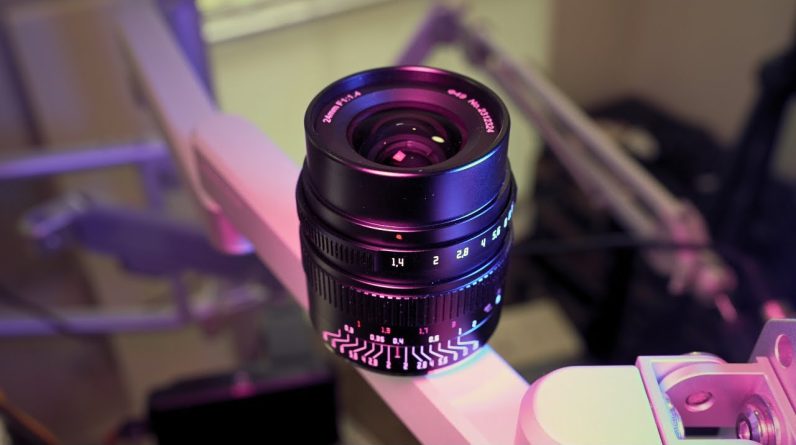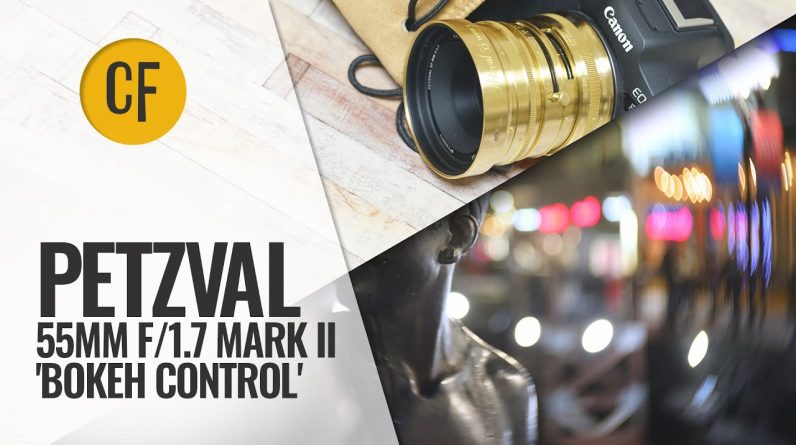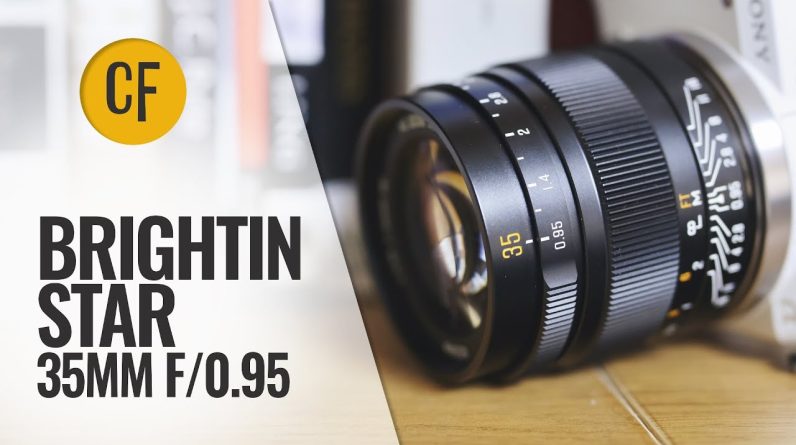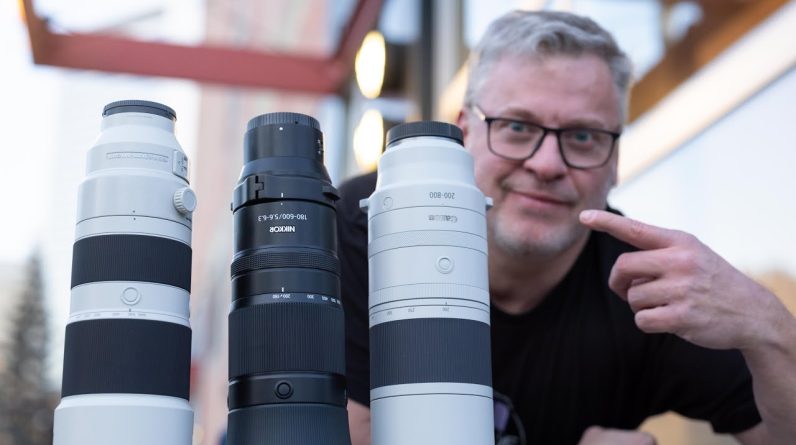Thanks to mpb for sponsoring this video Hi I'm Gordon from camera labs and this Is my full review of the sigma 60 to 600 Mil F 4.5 to 6.3 dgdn Sports a 10 times Optical zoom taking you from standard Coverage to Super telephoto announced in January 2023 and costing around two Thousand dollars or pounds it becomes The second member of sigma's sports Series that's been redeveloped for Mirrorless cameras and at the time I Made this review it's available for Sony E and Leica L mans fingers crossed for Other versions sooner rather than later Like many of sigma's lenses the 6600 Dgdn's primary specification is based on An existing model for dslrs in this case The 6600 dgos from late 2018 just over Four years later the new dgdn version For mirrorless cameras shares the same Range and focal ratio but it's a little Lighter and focuses both faster and a Bit closer the key proposition remain Means the same though namely that 10 Times Optical range taking you from Standard to Super telephoto with a Twist Of the zoom ring you're looking at an Example of that right now that I filmed With the new lens on the Sony a74 this Clearly makes it extremely flexible for The kinds of sports and Wildlife where The action can go from distant to fairly Close in just moments and that rules now Anytime you have to swap lenses now the
Sheer heft of this lens would ruler out A general purpose walk around option but As you'll see from my test shots Throughout this review that flexibility That Zoom range is actually equally Useful for landscape and even street Photography while it's currently the Only native mirrorless lens with a 60 to 600 range there are a number of Alternatives for anyone who wants to Zoom with Long Reach if you can live Without the initial 60 to 150 portion You could save yourself some money and Wait and go for sigma's own 150 to 600 Dgdm indeed Tamron slightly shorter 150 To 500 both reviewed on my camera Labs Website if you're happy to trade the Range at both ends there's a wealth of 100 to 400 options available or of Course if you want that 10 times range At a lower cost you could always adapt Sigma's older 60 to 600 DSLR version Which brings me to the sponsor of this Video mpb is the world's largest online Platform for used photo and video gear So when you're ready to buy sell or Trade head over to their website at Mpp.com for example at the time I made This video mpb was selling the older Sigma 6600 DSLR lens from 1339 pounds Now I'm quoting pounds as I'm from the UK but they also operate across Europe And the us another popular option for Sports and Wildlife photographers is the
Original Sigma 150 to 600 with the Higher end Sports version for dslrs Selling from 784 pounds in good Condition or the cheaper contemporary Version from 649 pounds all these DSLR Lenses can be adapted to some mirrorless Bodies of Desire it or if you have any Older gear that you're not using anymore Why not sell it to fund something new Mpb's online quotes include free Doorstep pickup and once they confirm The condition of your gear you can Choose to accept the quote and receive The money in your account the next day No post office hidden fees or Disgruntled buyers to deal with I've Been using mpb for several years now so When you have photo gear to buy sell or Trade I'd recommend checking them out at Mpb.com or using the links in the Description right back to the review Like his predecessor and other super Telephoto zooms the 6600 is a pretty Substantial lens 279 mil long that's Almost a foot 119 mil at its maximum Diameter and weighing in at a fraction Under two and a half kilograms this Makes it the same diameter as the older DSLR version but it's actually one Centimeter longer and while Sigma has Managed to reduce the weight by 200 Grams this is still a large and heavy Lens to carry around Sigma supplies the 60 to 600 with a
Large padded cuboid shaped bag complete With shoulder strap although like many Other super telephoto cases like this It's not long enough to also accommodate A body when it's actually mounted on the Lens although perhaps that's a Deliberate move in order to avoid damage During transportation again in line with Other super Tellies the 60 to 600 is Also supplied with a padded lens cover That slips over the end of the hood and Works as a protective cap if you prefer Sigma also supplies a more traditional Plastic lens cap the lens itself is Actually packed with this padded cover Fitted and removing it reveals the hood Reversed over the barrel this is held in Place with an old screw and adds a Further 60 mil to the overall length When it's fitted a rubber tip around the Front of the hood also reduces slips if You're standing it up when not in use This is actually quite a common way to Rest a super telephoto lens so don't be Alarmed as you'd expect for a heavy lens There's a built-in collar allowing the Barrel to rotate smoothly through 360 Degrees with a locking screw to keep it In place sigmas also thoughtfully Provided Notches at 90 degree intervals With nice tactile feedback for each so You can quickly switch between landscape And portrait orientations the collar Also features a pair of generous lugs
For use with a supplied strap as this is How you should carry the lens to avoid Damage to your camera's lens mount like Sigma's other larger lenses the foot Itself has an ARCA Swiss dovetail so you Can slide it straight into compatible Clamps without a plate or appear not my Manfrotto tripod here note for security Sigma recommends using screw based Clamps rather than levered ones which May not take the weight of the lens the Foot itself is actually a removable Accessory model ts121 allowing you to Swap it for something longer if Preferred for example the optional Ts-101 foot gives you a longer dovetail For easier balancing with different Bodies safe with a battery grip not to Mention more to hold on to if you're Using it as a carrying handle Interestingly if you place an new lens Next to the older version seen here on The right you'll notice the latter was Actually supplied with that longer foot As standard the shorter foot seen on the Newer model on the left may be down to Its lighter weight or perhaps a small Cost saving as it is a cheaper accessory You can also see how the older lens is Attached shorter although if you're Adding an adapter for a mirrorless Camera the overall length will become a Little longer in terms of controls There's four switches near the Mount
Including a focus limiter and two custom Modes there's also two Optical Stabilization modes with option two Disabling the panning Direction so you Can more easily follow Wildlife or Sports Action horizontally while still Enjoying the benefit of stabilization in The vertical axis meanwhile the custom Switch lets you fine-tune the optical Stabilization C1 sets it to Dynamic view Which quickly applies stabilization as You rapidly recompose C2 sets it to Moderate view which tries to balance Purposeful adjustments against unwanted Camera Shake if you have the lman Version of the lens and the option USB Dock you can further customize these Settings along with actually adjusting The focus limited distances the first Ring on the barrel is for manual focus Freely spinning and very smoothing Operation like most native mirrorless Lenses there's no distance markers in The physical window and the manual Focusing employs a motorized fly-by-wire System the second wider ring adjust the Zoom which gradually extends the Barrel In one section by around 95 mil the Barrel also has marks at 10 focal length Intervals from 60 to 600 and each can be Locked in position using a switch on the Side as long as you're not at the Extreme ends you can unlock the barrel With a firm twist or just flip the
Switch it preferred it all works very Well in practice and I never experienced Any creep where the barrel can actually Fall back or extend under its own weight Like sigma's other big zooms you can Alternatively adjust the focal length by Simply grabbing the end of the barrel And pushing it back and forth this can Work well for subjects moving quickly or Erratically towards and away from you Between the focus and zoom rings are Three buttons which all share the same Function and which can be programmed by Compatible camera bodies for example to Hold the focus Sigma describes the lens As being dust and splash resistant Including a rubber grommet at the Mounds Certainly I experienced no issues using It during light rain and pretty stormy Conditions by the Sea during testing in The absence of a rear mounted system for Filters though you will need to splurge On fairly substantial 105 millimeter Filters for the front end okay now for My Optical results starting with Coverage and to illustrate the huge Range at your disposal I'm going to show You a bunch of shots taken at the Extreme ends so 60 then 600 unless Otherwise stated all my tests were made With their e-mount version of the lens On the Sony a74 body now the 60 to 600 Isn't the first Native full frame Mirrorless lens with a 10 times Optical
Range for example both Canon and Sony Have 24 to 240 models but as you'll see In these examples there's a big Difference at both ends of the range the Sigma may not deliver anything wider Than standard coverage at the short end But by extending all the way to 600 mil It can better reach much smaller or more Distant subjects so while a 20 to 40 is A great general purpose walk around Range 60 to 600 is more suitable for Sports and Wildlife and I'll be showing You some action sequences soon it's also Ideal for tighter views of the sun when It rises or sets although as always do So at your own risk I only do this Without a filter when the sun is just Above the Horizon and greatly dimmed by The atmosphere or any clouds if it's Good for the sun it's equally good for The moon seen here at 600 mil on the Sony a74 as you crop in on the image you Can more easily see some of the surface Details although since the phase here Was close to full it's not ideal Conditions for that if you'd like to Know more about photographing the moon I Have two tutorials on my channel one for General shots and the second Specifically for eclipses so check them Out if you're interested if 600 mil Isn't long enough the L Mount version of The zoom is also compatible with sigma's 1.4 and 2 times L Mount converters
Extending the maximum focal length to 840 and 1200 mil respectively now Sigma Doesn't make TCS for Sony e-mount and There's no official support for the zoom With Sony's own converters but if you Have had a chance to try this Combination do let me know to test the Optical quality of the lens I Photographed bright and Pier for my Usual location which is about 140 meters Away and I rotated the barrel so that Details ran into each corner I'm Starting here at the shortest focal Length of 60 mil and at the maximum Aperture of f 4.5 note due to poor Weather I had to shoot this sequence Earlier in the day than I normally do so The results are less contrasty than my Other reviews due to the position of the Sun taking a closer look reveals plenty Of fine details with no benefit to Closing the aperture any further at Least in the middle of the frame where The lens was focused so now let's head Out to the far corner of the image and Remember like my other lens test I've Stayed focused on the middle of the Frame to judge field flatness here the Result stays pretty sharp and detailed With only some darkening due to Vignetting to mention as you close the Aperture you can gradually lift this Corner Darkness now for the same view Roughly Midway through the focal range
At 250 mil where the maximum aperture Reduces to F 5.6 zooming in on the image Here again shows the lenses capable of Capturing very crisp details in the Middle even with the aperture wide open And as before there's no benefit to the Sharpness by closing the aperture Scrolling over to the far Corner shows The lens maintaining this quality and as Before the only thing to mention again Is some darkening due to vignetting at The maximum aperture as you gradually Close the aperture this darkening is Again reduced although again there's no Benefit to the actual detail and now Finally a very tight view of the pier at The longest focal length of 600 mil Where the maximum aperture reduces a Little further to F 6.3 okay I'm going To mention the exact points at which the App to change is in just a moment Zooming in on this image shows details In the construction we rarely see in my Lens tests including the structure that Actually supports the Brighton Pierce Sign additional lighting and a chimney Vent taking a closer look shows the Image to again be very well corrected And packed with detail even under the Lower contrast lighting conditions at The time of shooting this test there's No improvement to the detail when Closing the aperture here heading into The corner shows the lens maintaining
Fine details even at the maximum Aperture and this time I didn't really Notice much vignetting either so when Shooting distant subjects the sigma 60 To 600 dgdm delivers excellent resource Across the frame and throughout the Range although as indeed did its Predecessor while super telephotos are Typically pointed at distant subjects They can often deliver surprisingly Effective close-ups and I'm going to Show a few examples for you like its Predecessor the closest focusing and Maximum magnification occurs at the 200mm to focal length which I've used For all of these shots although it will Now focus a bit closer down to 45 rather Than 60 centimeters at this point and That allows it to deliver greater Reproduction of 1 to 2.4 If you're shooting at the longest focal Length the closest focusing distance Remains the Same 2.6 meters as before Now many lenses become softer at close Range but I was impressed by the Sharpness of the new Sigma like most Super zooms though the overall focal Range will appear to reduce a little When focusing at closer distances are Measured more like an eight times Optical range with a sigma when it was Focused from about 3 meters away moving On the 60 to 600 shares the same Variable aperture as its predecessor of
F 4.5 to 6.3 the largest aperture of f 4.5 is available between 60 and 78 mil Then it closes to F5 until 139 mil then To F 5.6 until 365 then it's days at F 6.3 until the longest focal length of 600 mil you're not going to get anything Brighter without spending considerably More but there's still some Opportunities for shallower depth of Field effects if you can get close to Your subject or position it far from the Background you've already seen what you Can do in a macro Croatian environment So let's now see how it performs a more Of a portrait distance so here I am with The sigma at 60 mil 4.5 and surprisingly There's not a huge amount of blow in the Background but there's still some Subject separation and if you zoom in For a closer look at the image you'll See the subject details are very sharp And that the background is pretty Smoothly rendered without any Distracting busyness for more blowing on A portrait get the subject to stand Further back as you zoom further in Here's what you can expect at 250 mil 5.6 where you can see the perspective Has changed quite a lot with less of a Distracting background too and once Again the details on my face are sharp And the rendering behind me well behaved But the length of my garden now means That I'm stood closer to the rear wall
So let's see what you can do with more Distant backgrounds and even longer Focal lengths I snapped this shot with The lens fully zoomed into 600 mil and With the aperture wide open at F 6.3 Where the background has become more Blurred here's another couple of street Style shots with the land into the long End showing not just the potential for Subject separation but also the effect Of compression in the background if You're used to seeing portraits or Candids at more traditional focal Lengths the difference at 500 to 600 Millimeter can be quite dramatic to say The least sure these kind of lenses may Be primarily designed for sports and Wildlife but you can actually have a lot Of fun doing Street photos too and not Just of human subjects either as these Furry friends can attest for a more Formal test of rendering I've Photographed my usual ornament Arrangement with the Sigma lens at 200ml From its closest focusing distance Remember this is the focal length where You'll achieve the greatest Magnification here the subject was Actually about 20 centimeters from the Front of the lens Barrel itself at this Focal length distance and at the maximum Aperture of f 5.6 the bokeh blobs are Absolutely enormous and also avoiding Any visible onion ringing meanwhile any
Textures you see within the blobs could Actually be down to dust on the front Element as I close the aperture one stop At a time the blobs take on the shape of The nine blade diaphragm system but at Most settings the rendering of them is Actually reasonably circular moving on To focusing Sigma claims to now be using A faster motor than before and certainly In this first test where I've recorded The view at 60mm F 4.5 is pretty Swift At racking between the two bottles this Is in AFS mode here's the same test During video again at 60 mil 4.5 where The lens on an a74 body can smoothly Rack focus without any issues okay now Let's try it at a longer focal length Roughly Midway through the range at 300 Mil 5.6 again for Stills with a central Area and in single AFS mode here I'd say It's a tad slower than before maybe Slightly more hesitant at times but Still doing a fair job but in the past I Found that Sigma lenses can actually Focus much faster on Sony bodies when Set to continuous autofocus or AFC where The body uses its phase detect system Now I'll see the difference with the a74 Set to AFC mode the focus pulls between The bottles is much faster in fact Almost instant so if you want the Fastest autofocus with Sigma lenses on Sony bodies even for static subjects I'd Consider using AFC and now here's the
Same focal length but for video which on Most Sony bodies uses continuous Autofocus anyway so it's no surprise to Find the pair easily refocusing between The bottles without overshooting taking This to a logical extreme here's a photo Focusing test at 600 mil F 6.3 where I've had to move indoors place the Bottle on my window ledge and shoot it From about three meters away with the 8 Meter length of my garden behind it I'm Using continuous AFC here for the best Results and you can see how quickly the Camera is focusing between the bottle And the tray at the bottom of my garden I remember this subject is almost at the Minimum focusing distance and for good Measure the video version again at 600 ML F 6.3 from about 3 meters away from The bottle where the camera and lens Smoothly racking between the bottle and The background for reference that's the Tree you can see in my first portrait Shots earlier so a solid set of results Here but how about face tracking here's Some examples of the Sigma lens at 60mm 4.5 using face tracking across the frame On the Sony a74 sure as you saw earlier There's not a hugely blurred background At this aperture in distance but it all Works fine and to make it a bit harder a Similar face tracking test but this time A 200 mil 5.6 as the lens refocuses You'll notice it's pretty well behaved
In terms of focus breathing but let's Have a quick test specifically for that So here's the 60 to 600 at 60 mil Manually focusing between infinity and The closest distance then back again Here there's virtually no Focus Breathing to speak of with the Composition maintaining its Magnification throughout the focusing Range and now at the long end of 600 mil Where the depth of field even at F22 Here means it's quite hard to see what's Going on but as I focus when Affinity to The closest distance and back again you Should notice that the details do remain Roughly the same size so from these Tests there's little to no Focus Breathing evident on the sigma Zoom I Also thought it'd be fun to try out the Lens for auto focusing during slow Motion video especially at the longer End of its range so here's a few clips That I've filmed mostly around 600 mil Using the Sony a74 in its 1080 100p mode Which is slowed by four times here Thank you Foreign Foreign Butter for this kind of lens is going to Be action photography so before my final Verdict here's a selection of birds that I took with the sigma 60 to 600 all on The Sony a74 see in a minute Foreign
Foreign Foreign What's that you also want to see how the Lens looks on an aps-c body where its Field of view is reduced to become a 90 To 900 mil sure thing here's a shot Taken with my Sony a6400 at an Equivalent of 850 mil so a little Shorter than the maximum to fit the top Of the tower and wind farm without Cropping And here's an obligatory shot of the Moon at an equivalent of 900 mil weighs 50 larger than my earlier shot taken With a full-frame camera Zooming in for a closer look shows us Plenty of resolution available if you Need it although if you're photographing The moon or indeed any other very Distant objects do be sure to take lots Of shots to maximize your chances of a Sharp one with minimal atmospheric Disturbance which now finally brings me To my final verdict and as always I'm Going to show you a selection of photos Taken with the sigma 6600 dgdn on the Sony a74 body and if you'd like a close Look you can access some of the original Images via my review of the lens at Cameralabs.com the sigma 60-600 dgdn Delivers a unique range for mirrorless Cameras taking you from roughly standard Coverage to Super telephoto making it Ideal for Sports Action and Wildlife
Photography where the subject can Quickly move between near and far if you Don't have time to change your lens or Don't want the hassle of carrying a twin Body system in that scenario this single Lens will do it all as a member of Sigma's sport series it also does so With excellent quality across the frame And throughout the range even at the Maximum aperture sure you're not going To enjoy the shallower depth of field of A brighter super tough photo Prime like A 600 F4 or 400 2.8 but the sigma is Lighter and cheaper than those models While also having the flexibility of That Zoom range and surprisingly useful Close-up capabilities too that said While it is lighter than the 600 Therefore it's still a very substantial Lens weighing around two and a half Kilograms now I personally managed to Wield it handheld for short bursts Helped by decent Optical stabilization But I'd really recommend using a monopod Or some other stand for any longer Periods you should also think very Carefully about whether you'd regularly Exploit the full 10 times range in Particular the starting portion between 60 and 150 mil if you're happy starting At 150 you could go for sigma's 150 to 600 dgdn at two thirds of the price and 400 grams lighter or if you don't need 600 mL this tamron's 150 to 500 100 not
To mention a variety of 100 400 options Available and If you're happy with Adapted performance you could always Save some cash and go for sigma's Original 60 to 600 DSLR version now Thanks to Sigma and Tamron we now enjoy A wealth of long zooms often with unique Ranges and at lower prices the models From the big camera companies themselves The 60 to 600 dgdn is a worthy update to The original DSLR version for mirrorless Cameras focusing faster and closer than Before while also losing a little weight Too if you truly desire this full range And can accommodate its heft I can Highly recommend it the only thing that Could actually make it any better is Availability in more than just Sony E And Leica L mounts so fingers crossed a And that's it for this review as always I'd love to hear what you think in the Comments and if you found any of it Useful please do consider giving it a Like and also my channel to follow Thanks again to mpb for sponsoring this Video if you have any photo gear to buy Sell or trade do check them out at Mpb.com or using the links in the Description I'll see you next time bye






